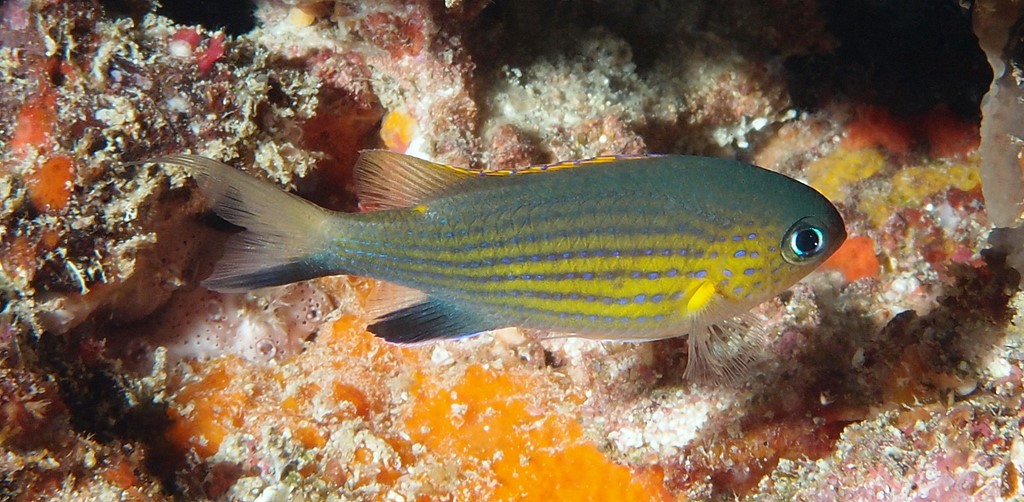PYCNOCHROMIS VANDERBILTI - (FOWLER, 1941)
Actinopterygii (Gigaclass) > Actinopteri (Class) > Teleostei (Subclass) > Blenniiformes (Order) > Pomacentridae (Family) > Chrominae (Subfamily) > Pycnochromis (Genus)
Chromis rayé, Chromis de Vanderbilt, Vanderbilt's chromis, Vanderbilt's puller, Hime-suzumedai, ヒメスズメダイ, 凡氏光鰓魚, 凡氏光鰓雀鯛,
Synonyme
Chromis vanderbilti (Fowler, 1941)
--------------------------
Description
Dorsal spines (total): 12; Dorsal soft rays (total): 10-12; Anal spines: 2; Anal soft rays: 10-12; Pectoral fin rays: 16-18; Lateral line scales: 16-18; Gill rakers: 23-27; Body depth: 2.3-2.7 in SL. Max. length: 6.0 cm TL. Depth range: 2 - 20 m.
Color
Alternating blue and yellow stripes on body. The caudal fin has a broad yellow upper lobe margin and a broad black lower lobe margin. The margin of the spinous portion of the dorsal fin is broadly yellow. The anal fin is largely black.
Etymology
Pycnochromis: from ancient Greek, puknós = dense, compact, thick. Referring to “very smooth” head of Pycnochromis vanderbilti, the “edges of the suborbitals, preopercle and opercle little distinct” + from chromis: from Greek, chroemo = to neigh. A name dating to Aristotle, referring to a drum (Sciaenidae) and its ability to make noise; Later applied to this damselfish and subsequently expanded to embrace dottybacks, cichlids and wrasses (all perch-like fishes once thought to be related).
vanderbilti: in honor of yachtsman and explorer George W. Vanderbilt III (1914-1961).
Original description: Pycnochromis vanderbilti Fowler, 1941 - Type locality: Waianae, Oahu Island, Hawaiian Islands.
Distribution
Western and central Pacific: Philippines, east to Hawaiian Islands and Pitcairn Group, north to Amami Islands (southern Japan), south to Western Australia, Queensland (Australia), Lord Howe Island, New Caledonia, Kermadec Islands and New Zealand, Tonga and Rapa.
Biology
Adults occur in small to large aggregations in exposed outer reef slopes and rocky inshore reefs. Benthopelagic. Diet consists of zooplankton, especially copepods. Oviparous, distinct pairing during breeding. Eggs are demersal and adhere to the substrate. Males guard and aerate the eggs. Aquarium fish.
Similar species
Last update: 11, June 2023
Chromis rayé, Chromis de Vanderbilt, Vanderbilt's chromis, Vanderbilt's puller, Hime-suzumedai, ヒメスズメダイ, 凡氏光鰓魚, 凡氏光鰓雀鯛,
Synonyme
Chromis vanderbilti (Fowler, 1941)
--------------------------
Description
Dorsal spines (total): 12; Dorsal soft rays (total): 10-12; Anal spines: 2; Anal soft rays: 10-12; Pectoral fin rays: 16-18; Lateral line scales: 16-18; Gill rakers: 23-27; Body depth: 2.3-2.7 in SL. Max. length: 6.0 cm TL. Depth range: 2 - 20 m.
Color
Alternating blue and yellow stripes on body. The caudal fin has a broad yellow upper lobe margin and a broad black lower lobe margin. The margin of the spinous portion of the dorsal fin is broadly yellow. The anal fin is largely black.
Etymology
Pycnochromis: from ancient Greek, puknós = dense, compact, thick. Referring to “very smooth” head of Pycnochromis vanderbilti, the “edges of the suborbitals, preopercle and opercle little distinct” + from chromis: from Greek, chroemo = to neigh. A name dating to Aristotle, referring to a drum (Sciaenidae) and its ability to make noise; Later applied to this damselfish and subsequently expanded to embrace dottybacks, cichlids and wrasses (all perch-like fishes once thought to be related).
vanderbilti: in honor of yachtsman and explorer George W. Vanderbilt III (1914-1961).
Original description: Pycnochromis vanderbilti Fowler, 1941 - Type locality: Waianae, Oahu Island, Hawaiian Islands.
Distribution
Western and central Pacific: Philippines, east to Hawaiian Islands and Pitcairn Group, north to Amami Islands (southern Japan), south to Western Australia, Queensland (Australia), Lord Howe Island, New Caledonia, Kermadec Islands and New Zealand, Tonga and Rapa.
Biology
Adults occur in small to large aggregations in exposed outer reef slopes and rocky inshore reefs. Benthopelagic. Diet consists of zooplankton, especially copepods. Oviparous, distinct pairing during breeding. Eggs are demersal and adhere to the substrate. Males guard and aerate the eggs. Aquarium fish.
Similar species
- Pycnochromis acares (Randall & Swerdloff, 1973) - Reported from New Caledonia.
- Pycnochromis lineatus (Fowler & Bean, 1928) - Reported from Eastern Indian Ocean, western Pacific: Christmas Island (Australia) and Indonesia, east to Palau and Solomon Islands, south to northern Great Barrier Reef (Australia) and Vanuatu.
- Pycnochromis nigrurus (Smith, 1960) - Reported from Indian Ocean: Eastern Cape and KwaZulu-Natal (South Africa), East Africa, Seychelles, Aldabra (Seychelles), Comoros, Mozambique Strait, Madagascar and Mascarenes (La Réunion, Mauritius, Rodrigues), east to Indonesia.
Last update: 11, June 2023
